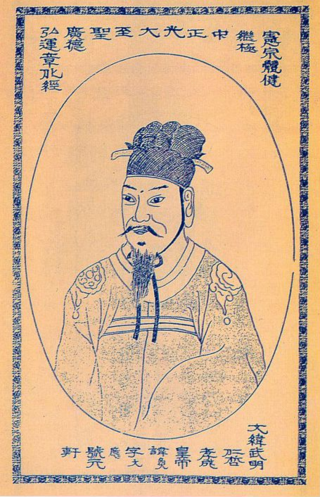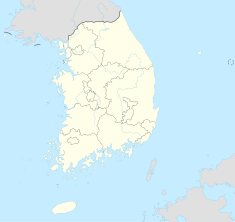
A tomb is a repository for the remains of the dead. It is generally any structurally enclosed interment space or burial chamber,of varying sizes. Placing a corpse into a tomb can be called immurement,although this word mainly means entombing people alive,and is a method of final disposition,as an alternative to cremation or burial.
Teti,less commonly known as Othoes,sometimes also Tata,Atat,or Athath in outdated sources,was the first king of the Sixth Dynasty of Egypt. He was buried at Saqqara. The exact length of his reign has been destroyed on the Turin King List but is believed to have been about 12 years.

A tumulus is a mound of earth and stones raised over a grave or graves. Tumuli are also known as barrows,burial mounds or kurgans,and may be found throughout much of the world. A cairn,which is a mound of stones built for various purposes,may also originally have been a tumulus.

Gyeonghui Palace,literally Palace of Serene Harmony is a palace located in Seoul,South Korea. It was one of the "Five Grand Palaces" built by the Joseon Dynasty.

National Treasure (Korean: 국보) is a national-level designation within the heritage preservation system of South Korea for tangible objects of significant artistic,cultural and historical value. Examples of objects include art,artifacts,sites,or buildings. It is administered by the Cultural Heritage Administration (CHA). Additions to the list are decided by the Cultural Heritage Committee.

Sunjo,personal name Yi Gong,was the 23rd monarch of the Joseon dynasty of Korea. He was the second son of King Jeongjo by his concubine,Royal Noble Consort Su of the Bannam Park clan.
Gyeongjong,personal name Yi Yun,was the 20th monarch of the Joseon dynasty of Korea. He was the eldest son of King Sukjong by his concubine,Royal Noble Consort Hui of the Indong Jang clan.

Heonjong,personal name Yi Hwan,was the 24th monarch of the Joseon dynasty of Korea. His father was Crown Prince Hyomyeong,who died at the age of 20 before becoming king,and his mother was Queen Sinjeong of the Pungyang Jo clan.

Seonjeongneung is a burial ground from the Joseon dynasty,located in Seoul,South Korea. The westernmost tomb,called Seonneung,belongs to King Seongjong (1457–1494) the 9th monarch of Joseon. His first wife,Queen Gonghye of the Cheongju Han clan (1456–1474) died at age 18 and is buried near Munsan,north of Seoul. His third wife,Queen Jeonghyeon of the Papyeong Yun clan (1462–1530),is buried here because she gave birth to the future King Jungjong. Queen Jeonghyeon outlived Seongjong by 35 years and was buried in a splendid tomb to the east. Her grave has a stone fence encircling the mound,whereas her husband's tomb has a retaining wall. Statues of civilian and military officials and their horses stand at attention in front of the graves. South of the tombs is a single T-shaped shrine. There are also several auxiliary buildings for storing the materials used during commemorative ceremonies.

The Tomb of King Muryeong,also known as Songsan-ri Tomb No. 7,is the ancient tumulus of King Muryeong,who ruled the Baekje from 501 to 523,and his queen. The rarity of intact Baekje tombs makes this one of the major archaeological discoveries in Korea and a crucial source for the understanding of Baekje,one of the Three Kingdoms of Korea.

The Tombs of the Joseon dynasty refers to the 40 tombs of members of the House of Yi,which ruled Korea between 1392–1910. These tombs are scattered over 18 locations across the Korean Peninsula. They were built to honor and respect the ancestors and their achievements,and assert their royal authority. The tombs have been registered as an UNESCO World Heritage Site since 2009. Two other Joseon tombs,located in Kaesong,North Korea,were proposed but not submitted.
The Hurung Royal Tomb (Korean: 후릉),also known as Huneung Royal Tomb,is a 15th-century mausoleum located in Ryongjong Village,Panmun-guyok,Kaesong,North Korea. The site consists of two separate burial mounds,which contain the remains of Jeongjong,the second king of the Joseon dynasty and son of its founder Taejo,as well as the body of his wife,Queen Jeongan. Construction on the tombs began after Queen Jeongan's death in 1412,and was only completed after Jeongjong himself died in 1419. Both tombs consist of a burial mound ringed with a carved granite base;they are surrounded by statues of the twelve zodiac animals. The "spirit road" up to the tombs is lined with statues of military officers and Confucian officials.
Herneith was a Queen consort of ancient Egypt. She lived during the 1st Dynasty. The name herneith means "The face of Neith".
Queen Jeongsun,of the Gyeongju Kim clan,was a posthumous name bestowed to the wife and second queen consort of Yi Geum,King Yeongjo,the 21st Joseon monarch. She was queen consort of Joseon from 1759 until her husband's death in 1776,after which she was honoured as Queen Dowager Yesun (예순왕대비) during the reign of her step-grandson Yi San,King Jeongjo and as Grand Queen Dowager Yesun (예순대왕대비) during the reign of her step great-grandson Yi Gong,King Sunjo.
Royal Noble Consort Su of the Bannam Park clan was a concubine of Jeongjo of Joseon and the mother of King Sunjo. She was also given an alternative royal title,Royal Noble Consort Yu.
Jangneung is a burial ground from the Joseon dynasty,where King Injo and his first wife,Queen Inyeol,were entombed. Located in Paju,Gyeonggi Province,it is recognized as an UNESCO World Heritage Site.
Crown Prince Munhyo,personal name Yi Sun,was the first son of Jeongjo of Joseon and his favorite concubine,Royal Noble Consort Ui of the Changnyeong Seong clan. He was the older half-brother of King Sunjo.
Princess Yeongon was the daughter of King Sunjo of Joseon and Royal Consort Sug-ui of the Miryang Park clan.
Princess Bokon was a Korean princess,as the second daughter of Sunjo of Joseon and Queen Sunwon of the Andong Kim clan.
Grand Internal Princess Consort Wanyang,of the Jeonju Choi clan,was a member of the Joseon royal family,as the legitimate wife of Grand Internal Prince Jeongye. As the primary consort,she became the adoptive mother of King Cheoljong of Joseon and was given the royal title after his ascension. She also bore Jeongye a son,Prince Hoepyeong.











